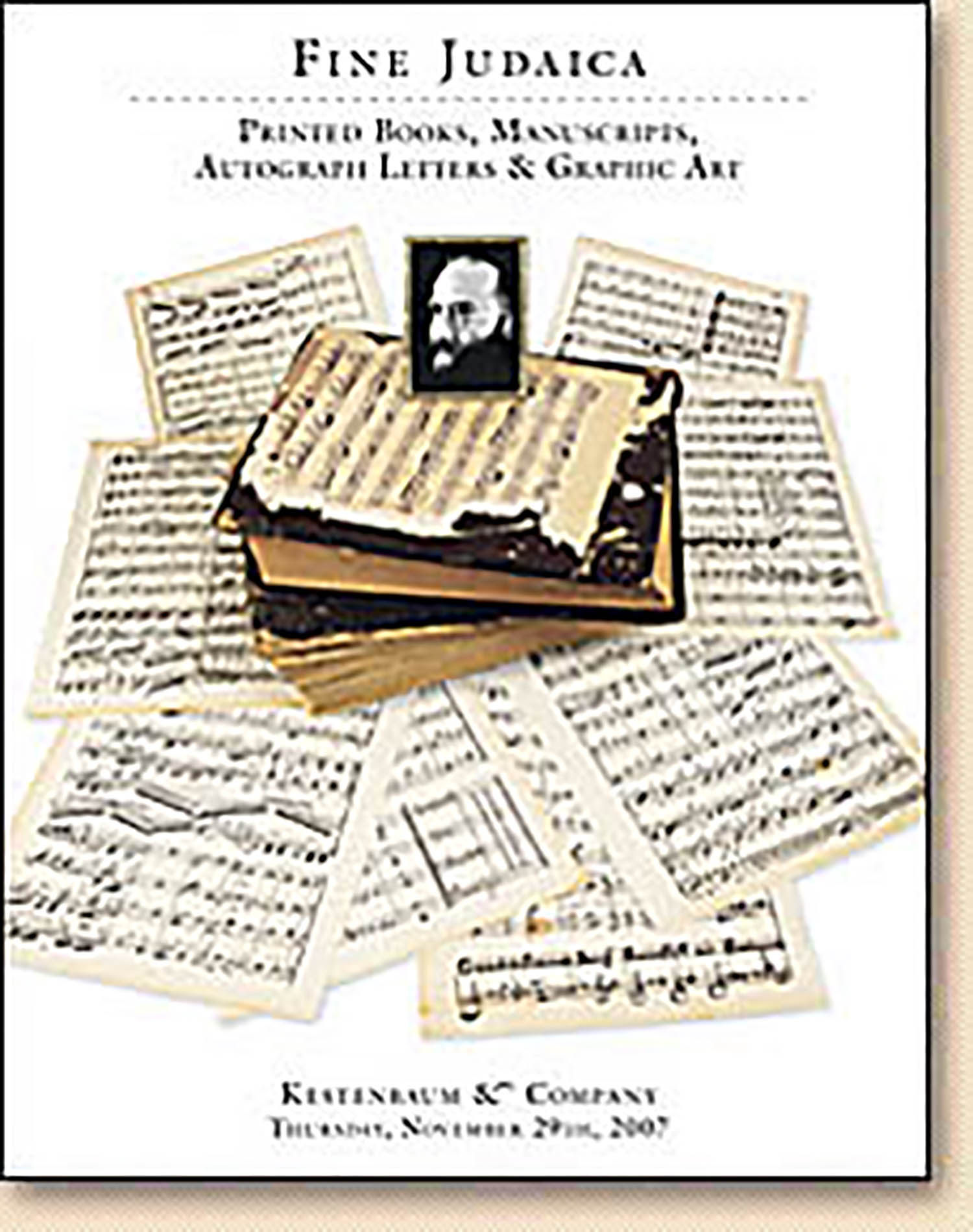Seder Hagadah shel Pesach. Illuminated Hebrew manuscript on paper

AUCTION 38 |
Thursday, November 29th,
2007 at 1:00
Fine Judaica: Printed Books, Manuscripts, Autograph Letters & Graphic Art
Lot 288
(HAGADAH)
Seder Hagadah shel Pesach. Illuminated Hebrew manuscript on paper
Ferrara, Italy: 1767
Est: $25,000 - $30,000
PRICE REALIZED $25,000
David Ahron Chai Cohen, for whom the Haggadah was executed, probably belonged to the great family of Chai (Vita) Coen, merchants and bankers of Ferrara. A member of this family served as Mayor of Ferrara during the Napoleonic Wars.
Following the vogue for well-to-do Jews to commission a scribe to execute a unique Hagadah, the artist of the present manuscript has utilized a rich palette, regaling the Hagadah with sumptuous hues. The illustrations are in the style of the Venice Hagadoth of 1609 and 1629, and are of great beauty, both in terms of color and elaboration.
Detailed description:
f.1 - The title is nested between double spiral columns, reminiscent of the ornate wooden Ark to be found in Italian synagogues of the period. Over the title, are hands extended in blessing, symbolic of kohanic lineage. Over the hands, hovers a crown, once again symbolizing the "crown of priesthood" (kether kehunah). (Cf. final leaf.) As the name would indicate, the owner of the Hagadah was a Cohen. At the outer extremities are visible two marble columns, colored gray. The motif of architectural columns prevails throughout the Hagadah, nuanced from leaf to leaf. The Hebrew text reads: Passover Hagadah with several illustrations…Ferrara.
f.4 - The initial word of the Kiddush, "Vayechulu" is conveyed in gold ink.
f.7 - The letter "Beith" of "Baruch" is historiated, portraying the master of the household holding high the beaker containing wine.
f.8 - Again, the letter "Beith" has been historiated, this time showing the master of the household moving his hand toward the flame, an integral part of the Havdalah ceremony recited Saturday night.
f. 10 - The artist has inserted as a tailpiece an intricate floral motif. Conceptually, a break is necessary here as the preliminaries are ending and the actual Hagadah or narrative portion is about to commence.
f. 11 - The first word "Hai" is celebrated by a rosiate surround. As for the text itself of "Hai-Lachma," note the interesting variant. Instead of the usual Hebrew "le-shanah ha-ba'ah," we have the Aramaic equivalent, "le-shata de-athya," unique to the Italian rite.
f.15 - Once again, the letter "Beith" of Baruch is historiated. This time, the master of the household is portrayed with head tilted heavenward, a pose symbolic of thanksgiving, appropriate to the blessing at hand.
f.16 - In the historiation of the letter "Cheth" for "Chacham," the Wise Son, the first of the Four Sons, is standing alongside the Paschal Lamb, a reference to the response given him: "According to the laws of Passover, we may not eat after consuming the Paschal Lamb." Note that the Wise Son dons the robe of a master of the law.
f.17 - Within the historiation of the letter "Reish" for "Rasha," we view the Wicked Son pursuing a Jew leading the Paschal Lamb to the slaughter, as if to remonstrate with him to cease and desist the divine service.
f. 18 - In the two vignettes reserved for the Simple Son and the Son "who wits not to ask," we see the process of preparing the Paschal Lamb has progressed. In the vignette above, the father, knife in hand, eviscerates the already slaughtered sheep. In the vignette below, the lamb is being skewered, the step before its actual roasting on the spit.
f.21 - As earlier (see f. 15), the master of the household raises his head in a gesture of blessing the Holy One.
f.31 - In the historiation of the letter "Vav" we see an avenging angel, sword in hand, flying over the cityscape of Jerusalem.
f.32 - In another historiated "Vav," we see Moses in the flowing robes and feathered turban of an Oriental potentate, extending his wonder-working staff. The wings of the staff suggest its divine potency.
f.34 - In this vignette, the two brothers Moses and Aaron appear before a seated Pharaoh to plead the cause of the Hebrew slaves.
f.38 - A husband and wife appear recounting the long list of miracles bestowed upon the Jewish People ("Dayenu").
f.43 - A reclining Rabban Gamliel, his legs sprawled out before him, is expounding upon the Law. His chair is of interesting design, two-tiered as it were.
f.45 - A bearded patriarch holds aloft the Matzah, in order to explain its significance to the young man opposite him.
f.46 - This time it is the Maror held up high, as its significance is explained.
f.49 - At this juncture, commencing the Hallel or Thanksgiving, taken from the Psalms of David, we see King David, harp in hand. Note the ermine robe cloaked around his shoulders.
f.51 - This typical hunting scene whereby the hunter sounds a horn, while his hound pursues a hare, has been borrowed from secular sources.
f. 55 - The roseate tailpiece indicates that the Hagadah has been completed.
f. 56 - Esthetically speaking, this additional title is essentially a replay of the first title page, with the exception of the Hebrew wording: Second Seder of the pleasant lad David Cohen, Ferrara. In Italy, as in the rest of the Diaspora, the Passover Seder would be celebrated a second night.
f.65 - The vignette depicts a Hebrew about to depart from Egypt, his earthly possessions wrapped in a wayfarer's bag over his shoulder and his wandering-stick in his hand.
f.66 - Again, we encounter King David, harp in hand, appropriate for the passage from the Psalms of David.
f.96 - The final leaf presents a heraldic version of the "Kether Kehunah" (Crown of Priesthood). Cf. title page.
